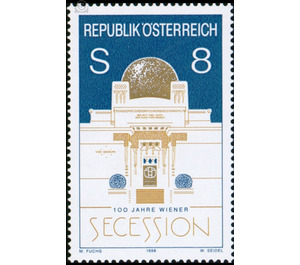100 years - Austria / II. Republic of Austria 1998 - 8 Shilling
Theme: Calender
| Country | Austria / II. Republic of Austria |
| Issue Date | 1998 |
| Face Value | 8.00 |
| Color | brown blue |
| Printing Type | combination printing |
| Stamp Type | Commemorative |
| Item Type | Stamp |
| Chronological Issue Number | 1590 |
| Chronological Chapter | OOS-OE2 |
| SID | 568516 |
| In 60 Wishlists | |
"Time their art, art their freedom". This programmatic leitmotiv can be read above the entrance to the building of the Vienna Secession, built in 1898. In 1897, a group of progressive artists, among them Gustav Klimt, Josef Hoffmann, Joseph M. Olbrich, Kolo Moser and Karl Moll, had renounced the conservative Künstlerhaus and founded the "Association of Fine Artists of the Vienna-Vienna Secession". It called for new aesthetic forms of expression adequate to modern life and a departure from the prevailing tendency of historicism. The art should be independent and able to develop freely, one did not want to be bound by a client and to keep clear of commercial interests. Prerequisite for this was an own exhibition house. This house was built in 1898 according to the plans of Joseph M. Olbrich, pupil and collaborator of Otto Wagner. It became a modern, functional building, the architectural form of which became a symbol of protest against the historic architecture of Vienna at the end of the 19th century. In the course of the eventful history of the Secession, the building was repeatedly rebuilt and expanded. In 1985, the long-overdue general renovation took place, which comes close to a new construction after the war damage and the subsequent destruction of the Olbrich space concept.


